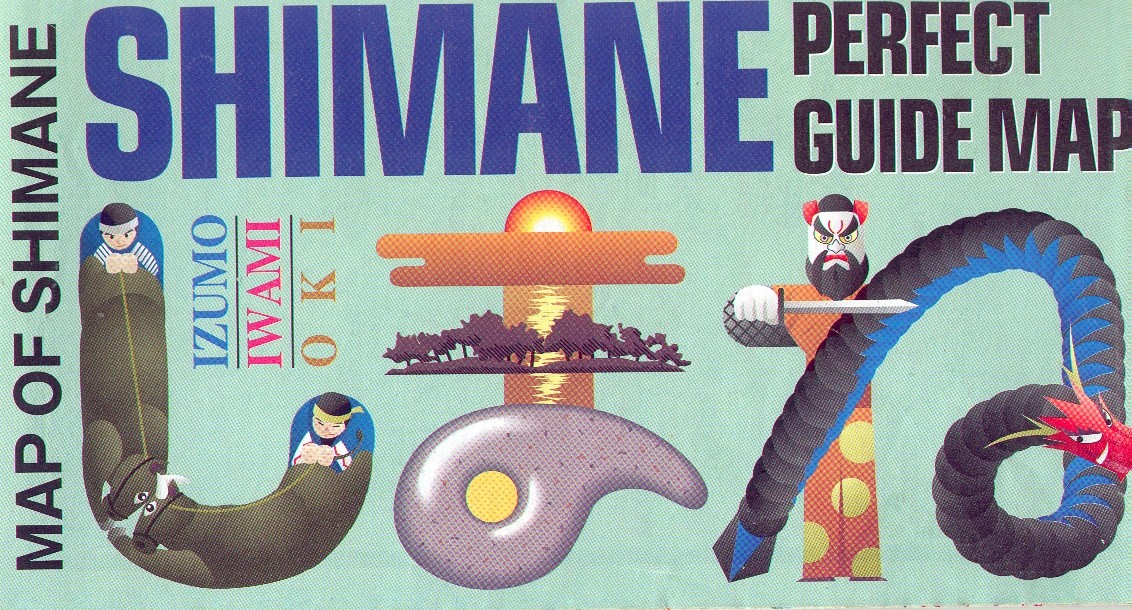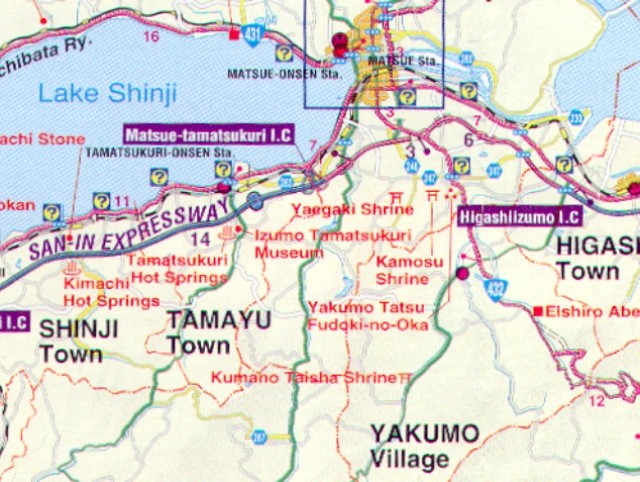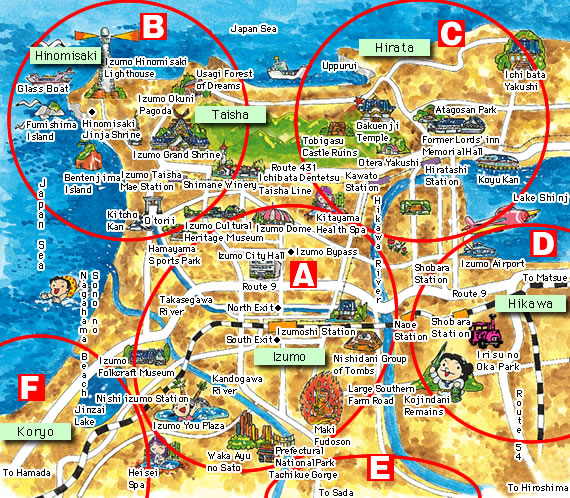Victimage in the Kojiki of Japan
by Barbara Mikolajewska in cooperation with F.E.J. Linton
| Copyright © 2007 by | New Haven, CT 06511-2208 USA | |
| First Internet Edition. All rights reserved. First created: 12 Apr 2006. Last updated: 01 Jan 2008. | ||
Supplements
![]()
Supplement 1. Shimane, the “Province of the Gods”
The “land of Izumo” that the Kojiki tells us Susa-nö-wo descended to upon being driven out of heaven presumably refers to the same territory as that occupied, at the time the Kojiki narrative was being written, by what was then known as the Province of Izumo, and this, in turn, can differ but little from that portion of contemporary Shimane Prefecture — the eastern third of Shimane’s onshore lands, in fact — now known as the former Province of Izumo. (The offshore portions of Shimane — its islands — make up the former Oki Province, while the western two-thirds of Shimane’s onshore lands were once the former Iwami Province.)
Mainland Shimane today is the broad northern swath of the central Chugoku Region of the main island of Honshu that, bordering the Sea of Japan, lies between the Prefectures of Tottori, to the east, Hiroshima, to the south, and Yamaguchi, to the west. Other coastal former Provinces in Chugoku that, like Izumo, also figure in Kojiki events include Iwami, adjacent to Izumo on the west, and Tottori’s Hoki, adjacent to Izumo on the east, and Inaba (of Rabbit fame), just to the east of Hoki. But this supplement will concentrate primarily on what Kojiki traces can still be found in Izumo Province itself.
|
|
Plate 1. The artist’s stylized renderings of the Hiragana glyphs Shi (し), Ma (ま), and Ne (ね) evoke the separation and confrontation of Izanagi and Izanami, the magatama bead in the context of earth, sea, heavens, and sun, and Susa-nö-wo slaying the Orochi dragon.
For example, the river Pii (Pï), along whose banks the newly descended and aimlessly wandering Susa-nö-wo heard the pitiable lamentations of the parents of the seemingly dragon-doomed Kusi-nada-pime (whom Susa-nö-wo would ultimately make his bride), seems to be today’s river Hii, or Hiikawa, that, from its source in Izumo’s Mount Sentsu, flows into the western end of Lake Shinji; and it was surely still within Izumo that Susa-nö-wo killed this eight-headed dragon that had been so terrorizing the countryside, and then extracted from its tail the famous sword Kusa-nagi, which would become part of the Imperial Regalia. Small wonder, then, that this dragon, known locally (in what looks like a dig at the formerly dominant Yamato clan) as Yamato-nö-Orochi, has become a central feature in the Izumo kagura festive and ritual dance tradition (and in that of Iwami kagura, as well).
It was, moreover, along the shores of Izumo that Susa-nö-wo’s distant descendant Opo-kuni-nusi, yielding to the advice of his son Kötö-shirö, ceded the earthly lands to Ama-terasu’s grandson Ninigi. Izanagi and Izanami also dwell here, in the sense that it is somewhere in the hinterlands of Izumo that is thought to be found the entrance to the Land of the Dead, into which Izanagi wandered in search of his deceased beloved Izanami, and out of which he was chased, with Izanami and the Spirits of the Dead in hot pursuit. [In fact, at least one source reports Izanami’s final resting place to be on Mount Hiba, close to the old Izumo-Hoki border, and near the present-day Izumo city of Yasugi.]
And the famous Kunibiki-shinwa, or “land-pulling” legend, according to which the local deity Yatsuka Mizuomi Tsunu no Mikoto enlarged the originally smaller land of Izumo by annexing to it pieces of land he pulled in from more distant, offshore places, has its focus in Izumo as well, the peak from which Yatsuka did his pulling being thought to be Iwami’s Mount Sanbe, near the Izumo border (cf. http://www.visitiwami.com/modules/overview0/ ), with the annexation terrain where he finished his work becoming known as the Ou District because — or so goes the Izumo tradition — marking the end of his work by striking a rod into the small forest where his work ended, he took a deep breath and emitted a loud, final, fatigued sigh of relief: “Oe” (or “Ou”). [This Ou District was the area within Izumo currently occupied by Matsue and Yasugi Cities, along with the southern part of what is now known as Yatsuka County, and adjacent environs.]
|
|
Plate 2. A map of the Matsue area, showing part of the ancient Ou district and some of the Ou Rokusha shrines.
All these figures are actively remembered here in Izumo, not only in such place names as Yatsuka or Izumo (itself derived, it is thought, from the very name of the goddess Izanami), but by the many shrines erected to their worship, some of which claim to trace their origins, through various relocations over time, to original places described in the Kojiki. Six Shimane shrines in particular, each with “a long and distinguished history,” seem to be of special importance: known jointly as the Ou Rokusha (“the six shrines of the Ou District”), and focus of the tradition, dating back to ancient times, of Rokusha Mairi, or “six-shrine pilgrimage festival,” these are: Manai Jinja, an Izanagi shrine, in Yamashiro-cho; Kamosu Jinja, an Izanami shrine, in Oba-cho; Iya Jinja, or Shrine of the Dead, in Higashi-Izumo-cho; Rokusho Jinja, the Six Deities — or Six Creation Gods — shrine, in Okusa-cho; Yaegaki Jinja, a Susa-nö-wo shrine, in Sakusa-cho; and Kumano (or Kumano Taisha) Jinja, another Susa-nö-wo shrine, in Yakumo-shi. The first four of these are the shrines to which the next supplement is devoted.
The supplement thereafter will visit the last two of these Ou Rokusha shrines, along with the following three: Susa Jinja, again dedicated to Susa-nö-wo, and to his bride Kusi-nada-Pime; Hinomisaki Jinja, dedicated to Susa-nö-wo and his sister Ama-terasu; and Sada Jinja, where are enshrined, as is the case at Rokusho Jinja, multiple creation deities — not only Susa-nö-wo, and Ama-terasu, but also Izanagi, Izanami, and Ninigi, as well as the more local deities Sada-no-Ookami, Kototokio-no-Mikoto, and Hayatamao-no-Mikoto.
|
|
Plate 3. Izumo Area Map with Hinomisaki Jinja, Izumo Taisha Jinja, Hii River, Lake Shinji, Izumo Town and Stations, and more.
Original found, formerly, at: http://www2.city.izumo.shimane.jp/e/sight_seeing/index.html (link no longer active now).
Another two Izumo shrines, freighted with perhaps even more importance, despite lying more distant from Matsue city, than the Ou Rokusha and Susa shrines just mentioned, are so noteworthy as to deserve a supplement apiece. These are: the famed Izumo Taisha Grand Shrine, located at the edge of the sea somewhat outside Izumo City, well beyond the western shores of Lake Shinji (on whose eastern shore lies the city of Matsue), where is enshrined the land-donor Opo-kuni-nusi (known also as Daikoku), to which all the kamï return annually from all over Japan for their traditional Kamimukaesai gathering; and Miho Jinja, the Miho Shrine, between Mihonoseki City and Mihonoseki Lighthouse, where Opo-kuni-nusi’s son Kotoshiro (sometimes also referred to as Ebisu) is enshrined.
|


